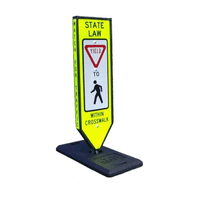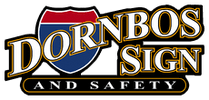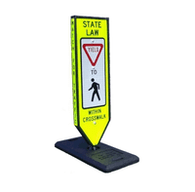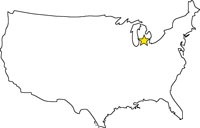How Can Fluorescent Yellow or Fluorescent Yellow-Green Diamond Grade High Visibility Crosswalk Signs Enhance Pedestrian Safety?
Posted by Jeffrey Dornbos on 9th Sep 2016

When you’re on the road, certain colors have specific meanings. For example: green means go, red says stop, and yellow tells road users to proceed with caution. But who decided the meaning of these colors? At some point in time, somebody had to!
In some cases, certain colors have always been used to declare specific messages to road users. For example, green meaning, “go,” and red meaning, “stop,” is universal; however, the color yellow and its variations have evolved over time.
When you’re approaching a stoplight and it switches from green to yellow, what goes through your head? Maybe you think, “Speed up!” Perhaps you slam on the breaks. Either way, a yellow light puts you on your toes: you know the light will turn red soon—so what will you do to avoid possible collision? The color yellow means “caution” and serves as a general warning for road users throughout the U.S.
Warning signs in the United States must be yellow, and they have been required to be so for a long time. Fluorescent yellow-green (FYG) became an extension of yellow warning signs approximately 20 years ago. Warning signs are only allowed to be fluorescent yellow-green if located in school zones or areas where pedestrians and bicyclists are present.
The History Behind Yellow and Fluorescent Yellow-Green Signs
In the 1990s, the Federal Highway Administrations’ (FHWA) Office of Transportation Operations wanted to find a way to reduce the frequency of accidents involving pedestrians and bicyclists. In 1992, the FHWA decided to test out fluorescent yellow-green warning signs on 5 pedestrian and bicycle crossings in Washington D.C. The results of the study indicated the FYG signs caught the attention of drivers more effectively than yellow.
In 1998, the Manual of Uniform Traffic Control Devices (MUTCD) published the suggestion of FYG signs being used in pedestrian, bicyclist, and school zone areas. In 2009, the MUTCD made it a law: every warning sign in a school zone or pedestrian/bicyclist area must be FYG.
Which Color Sign is Required—Yellow or Fluorescent Yellow-Green?
Every warning sign is yellow, but because FYG is more attention grabbing than yellow, signs in areas where pedestrians are present must be FYG. Signs allowed to be FYG are limited to pedestrian warning, bicycle warning, playground warning, school bus and school warning signs. Some warning signs can either be FYG or yellow, but if a sign is being placed in a school area then it must be FYG.
Typical Yellow Warning Signs:
- Prepare drivers for upcoming road conditions and hazards
- Include caution and direction traffic signs used to alert drivers of traffic pattern changes
- For example:
- “Slippery When Wet”
- “Stop Ahead”
- “Merging Traffic”
Fluorescent Yellow-Green Signs:
- Warn drivers they are entering an area near a school where children might be crossing the street
- For example:
- “School Crossing”
- “School Bus Stop Ahead”
- “Pedestrian Crossing”
Find Your Yellow and FYG Signs at Dornbos Sign & Safety, Inc.
Dornbos Sign & Safety, Inc. supplies a variety of yellow and fluorescent yellow-green road signs at an affordable price. We use extremely durable and reflective materials to ensure the road signs we sell will last a long time and match up with MUTCD standards. Check out our website today to learn more about Dornbos Sign & Safety, Inc. and our selection of signs and installation equipment. Reach out to us with any questions by calling 800-922-0029 or filling out our online contact form.




